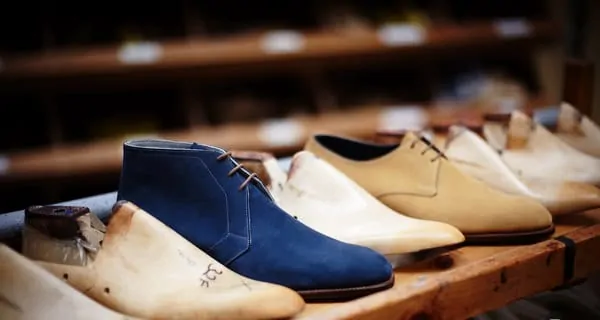
In this article, we’ll recount a visit to English shoemaker Edward Green. Recent years have witnessed the emergence of Gaziano & Girling, and the refocusing of Alfred Sargent on higher-end shoes, so it seems reasonable to assume that Edward Green are now facing more serious competition in the upper-end segment of British shoes. Following the departure of Tony Gaziano a few years ago, Edward Green discontinued their bespoke shoe programme, and expanded their made to order offering instead. Today, we take a close look at the factory and at how Edward Green shoes are made.
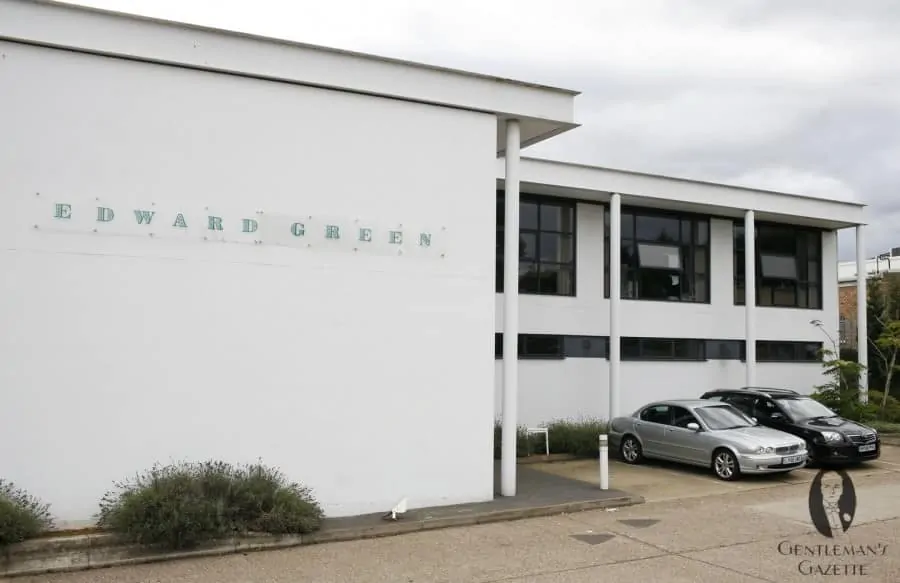
The frontispiece of Edward Green’s catalogue is tersely evocative of the active, early twentieth-century British country gentleman’s lifestyle:
Designers and makers of shoes for men to wear on all occasions — walking, service, riding, hunting, sport, dress etc. Est. 1890.
Yet this is no company that (even were such a thing possible) lies comfortably marooned in the past. I’m sitting in a shoe-filled boardroom – it’s a leather-fiend’s dream. I’ve visited many shoe factories; some are like time capsules, wonderful relics of Victorian industry that have somehow survived into the twenty-first century, newly awoken from some strange cataleptic episode to find themselves unexpectedly fashionable. In the case of Edward Green, however, a somewhat turbulent time saw them vacate their former factory at the heart of Northampton’s old but interesting boot- and shoe-making quarter; their new premises, in a suburban part of town, are very different – a sleekly modernist building of the type that more typically houses forensic research establishments or discreet medical facilities. An indication perhaps of the single-minded vision of excellence with which Edward Green are animated: a vision in which idle nostalgia can have no place.
Some history
Shoe historians will be aware that after several generations of stewardship, in the 1970s the Green family sold their shoe company to the American leather entrepreneur, Marley Hodgson. Financial difficulties subsequently saw the firm pass in 1982 to John Hlustik, an emigré Czech shoe designer who had trained in Italy and Spain. Hlustik is credited with restoring the firm’s emphasis on uncompromising quality, and also with introducing to Northampton his techniques of burnishing and antiquing leather. John Hlustik died suddenly in 2000 and it fell to his partner, Hilary Freeman, to take up leadership of the company.
Anyone with even a passing acquaintance with Edward Green’s shoes will know that they are the very embodiment of rich qualities of tradition and craftsmanship, epitomising the uncompromising type of high-end British perfectionism that finds alternative expression in certain luxury motor cars, rich-men’s yachts, precision-made double-barrelled shotguns, and Savile Row suits. Like all these other luxury goods, the investment of considerable resources in terms of both materials and craft is involved, and the shoes are available in strictly limited quantities: no more than 325 pairs a week.
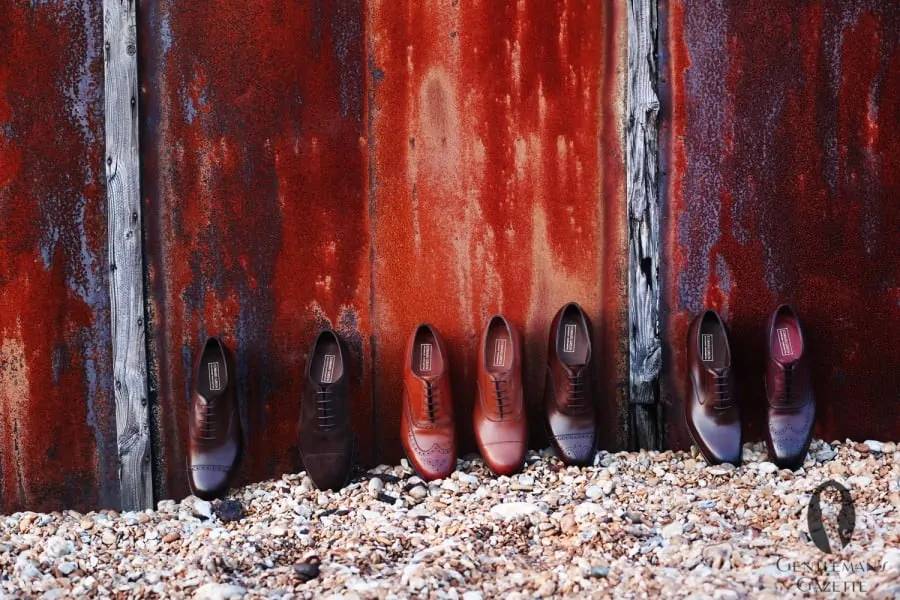
Edward Green – An Elegant Shoe
I am with John Hlustik’s nephew, Euan Denholm, Edward Green’s youthful Head of Brand and Business Development, who first relates to me the company’s evolving export trade. Although the UK market is increasingly important, exports still account for the lion’s share of the company’s sales. Edward Green shoes may be relatively hard to come by, but it seems they are available almost everywhere – well, anywhere of note. They have their own shop in London’s Jermyn Street of course, and one in Paris also. Euan mentions other stores – Isetan in Tokyo, Sak’s in New York – stores in Korea, Canada, Hong Kong, Hawaii, Russia. They can be found on the internet, but more so than most shoes, Edward Greens need to be seen in the flesh to be fully appreciated.
We talk briefly about lasts. The heightened level of interest among EG aficionados is such that many are able to discuss with apparent authority the subtle variations of the different Edward Green lasts. Self-evidently, these are a fundamental part of the shoes’ special appeal. However, I am curious about what else makes Edward Green shoes special. I ask Euan how he would characterize their shoes:
“First and foremost, we are about quality. There is a lot more handwork involved in making a pair of Edward Greens than in making a pair of any other shoes. We make a particularly refined and elegant shoe. Stylistically, an Edward Green is a very English look – there is a real elegance to the shoe.
“What do I mean by an English look? Usually this means in terms of Goodyear welted, which distinguishes us from French and Italian shoes. But there is also a real element of refinement and elegance.”
The word ‘elegant’ is being bandied about rather a lot. What exactly does it mean? Is it an entirely subjective concept, or is there some special characteristic that denotes elegance? I ask how elegance is achieved. He responds:
“It’s the last shape, it’s the manufacturing technique – an Edward Green is a very English shoe but has always had refined details. It’s a whole combination of things – the fact that the channel is closed after the Goodyear welt-stitch, the sole is typically bevelled more than other shoes – and the waist – and let’s look at the leathers.”
At this point, by some strange coincidence he places before me a version of the shoe that was my own first Edward Green, many years ago. It’s a burgundy-coloured Greenwich loafer. Elegant? Certainly. It is full of subtle, graceful curvature; the stitching is extremely precise and the calfskin uppers are beautifully soft and quite flawless. Made on the 909 last, the shoe’s toe is pleasingly elliptical. Something else as well – the shoe has a wonderful smell, a sort of cedarwood cigar-box aroma with whisky overtones.
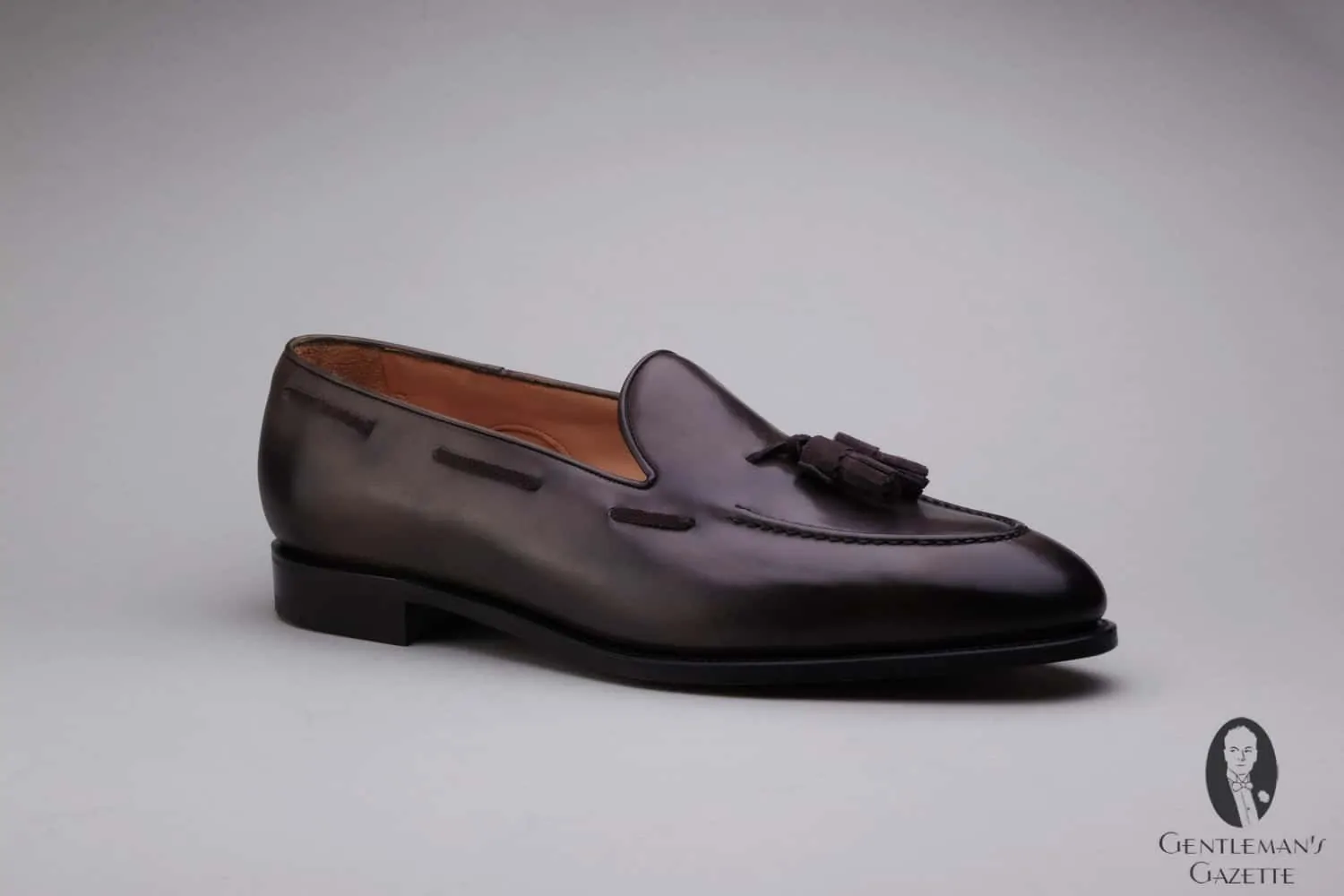
Now Euan brings out one of Edward Green’s bestsellers, the Chelsea Oxford. Again, beautifully crafted, and with swan’s neck stitching to either side of the lacing, it is certainly elegant. The leather – bauxite calf – is stunning; it is beautifully burnished. Are all their shoes as good as this, I wonder? Very well made, no doubt, and using only the finest leathers, but elegant is not a portmanteau word that is appropriate for every type of shoe. There are one or two of Edward Green’s other shoes that have a certain rugged quality to them (here I am thinking for example of the Dundee, a stout walking shoe; or the Bordon, a shoe with overtly military nuances) which is notable, but does not immediately impress one as ‘elegant’. The Chelsea, however, is a shoe that must confer on its delighted owner immediate distinction.
“When it comes to calfskin and soles, we go the extra mile to find the very finest suppliers. Some is from France, but most is from Italy. The sole leather is from a wonderful firm in Germany.”
Now, all that sounds great; but in this day and age, a Goodyear welt can be found in many shoes in the $300 range, and quite a few companies are supplied by Rendenbach for their sole leather. Moreover, antiqued and burnished leathers are increasingly popular, and many shoes last seemingly forever; nor is a channeled welt-stitch so hard to come by. So the question for the serious shoe-buyer is this: why spend £640 ($1100) on Edward Green shoes, when you may find fully bespoke shoes for less in other parts of the world – Vienna, for instance, or Budapest?
The pricing of Northampton shoes is an interesting topic. It has been a fairly widespread belief in some quarters that there is a clear correlation of price and quality – that there is a hierarchy of quality, with the price increasing accordingly in proportion. However, the relationship between cost and quality might appear to be less demonstrably objective at the upper end. Personally, I can accept, having now seen everything at the Edward Green factory, that the calf leather used is of superior quality, and also that their manufacturing processes are more laborious, all justifying a higher price for their shoes. Nevertheless, one has to question whether they might not be deliberately adopting a premium pricing strategy to position the brand in a particular way.
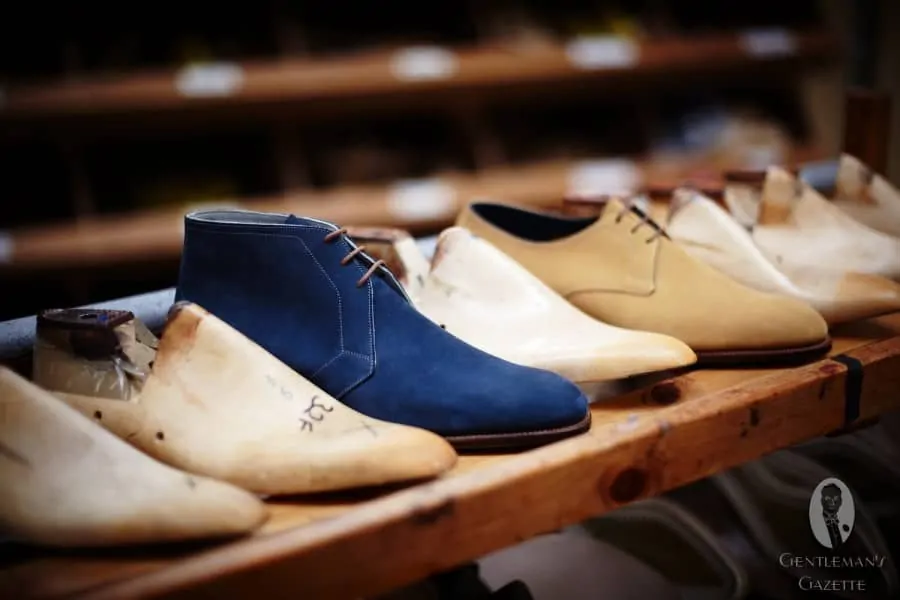
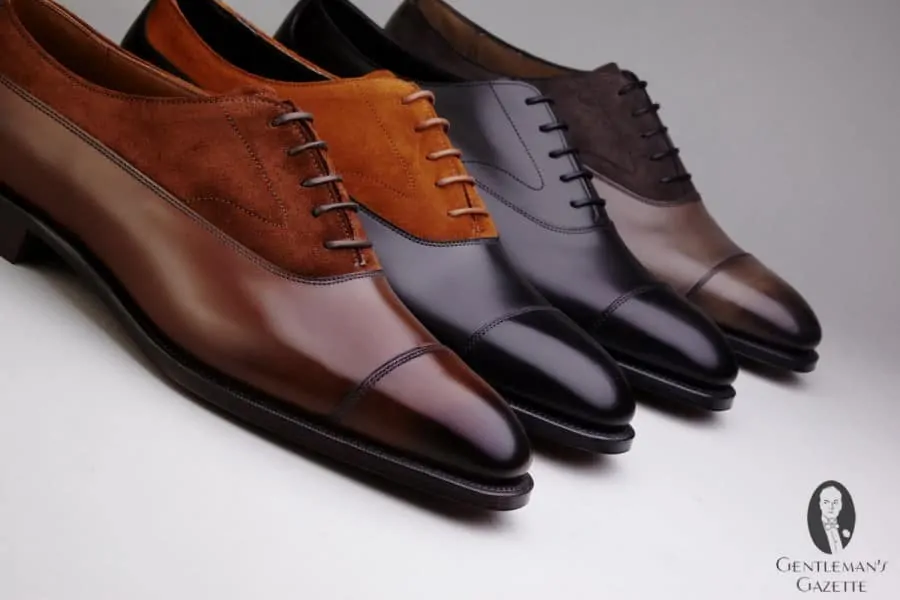
Arguably it is their classic, elegant English lasts which remain one of Edward Green’s biggest assets. Their burnishing and antiquing processes are also at least among the best in the industry – although lately, more shoemakers are paying the utmost attention to the finishing processes, and there has been an increase in the quality of burnished and antiqued shoes in the industry.
Although I myself have not encountered this phenomenon, one thing Sven Raphael Schneider has commented upon in the past with regard to Edward Green shoes has been an apparently excessive creasing of the vamp, and incorrect orientation of the plane of the heel with regard to that of the sole, such that, if he stood with the heel flat, the sole did not quite touch the floor. This is something many shoe manufacturers don’t get right, yet, when considering the price of Edward Green shoes, should surely be perfect. Of course we have to observe that the fit of any ready-made shoe is always dependent upon a close approximation of the shape of the individual’s foot to that of the last, rather than the other way round; yet other factors may be at play here. In fact Edward Green, as we see below, take some care over the lasting process, so any diagnosis of Mr Schneider’s problems of creasing, without more detailed investigation that is beyond the scope of the present tour, can only be tentative.
At this point we leave the boardroom to begin our tour of the factory, which lies immediately downstairs.
The Edward Green Factory Tour
In the clicking room
In the clicking room, the senior clicker talks to me about his work as I watch him cutting shapes from a cobalt blue deerskin. Each upper is cut out individually, using only the choicest portions of hide. While some shoemakers will cut out uppers with the utmost economy, so that no precious calfskin is wasted, at Edward Green they use only the perfect areas, and a single calfskin will yield a sufficient area of perfect leather for no more than two or three pairs of uppers. I am handed two squares of leather from the unwanted portion of hide – these look fairly perfect at first glance, until an almost imperceptible waviness of texture is pointed out to me.
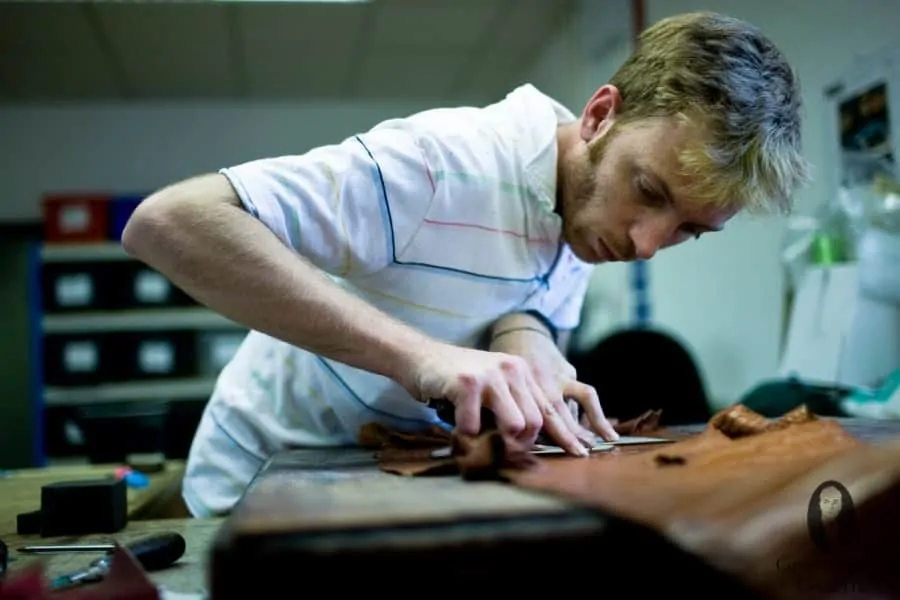
Globally, there is a limited supply of fine leathers, and the very finest are available in even more limited quantities. This can be a problem for high-volume makers, but is slightly less so for a firm such as Edward Green whose customers, necessarily, are a highly select set. Occasionally, ethically sourced exotic leathers such as deerskin, stingray, crocodile, and even rarer hides, are used, but only for one-off orders.
The closing room
We move on to the closing room. Each worker here assembles an entire upper, rather than, as in some shoe factories, a small part only. I am invited to inspect a newly stitched upper in cloud calfskin – a sort of dove grey colour which burnishes to an antiquey washed-out black tone. The lines of stitching follow the delicate curves of the vamp and counter, seemingly with micrometer accuracy, each stitch gauged to precisely one-twelfth of an inch.
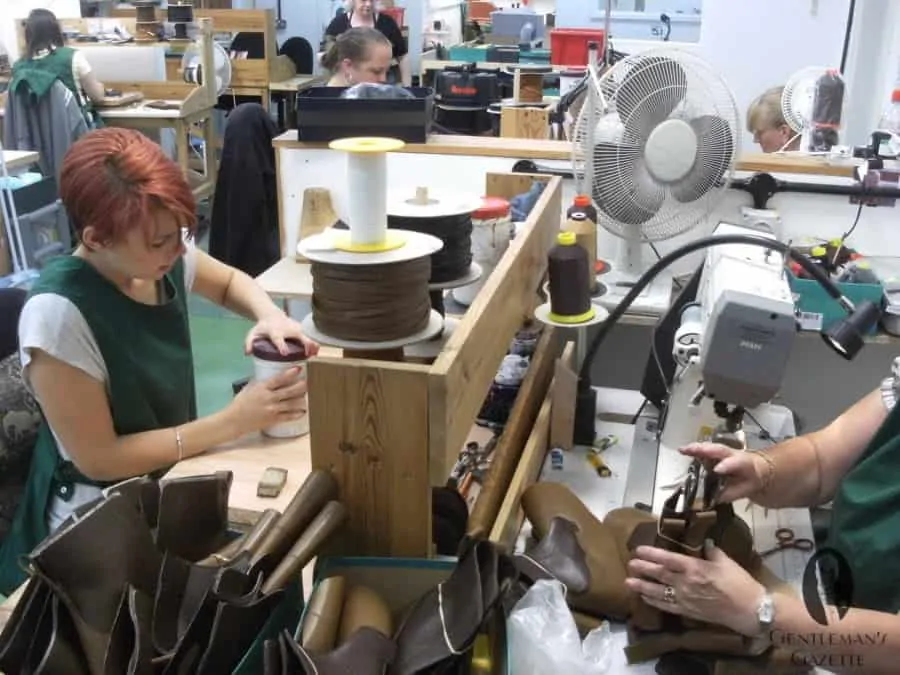
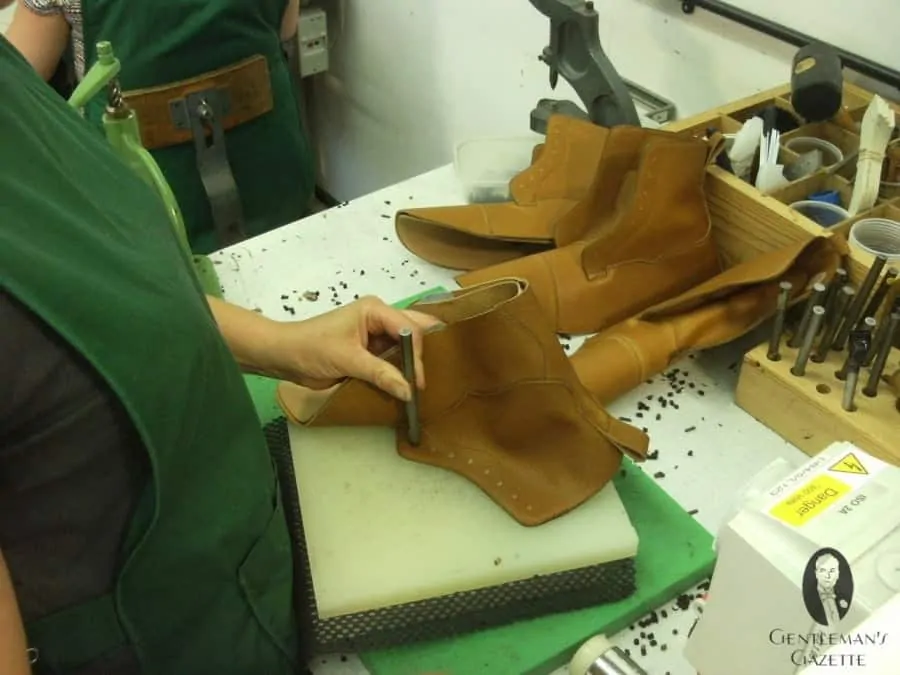
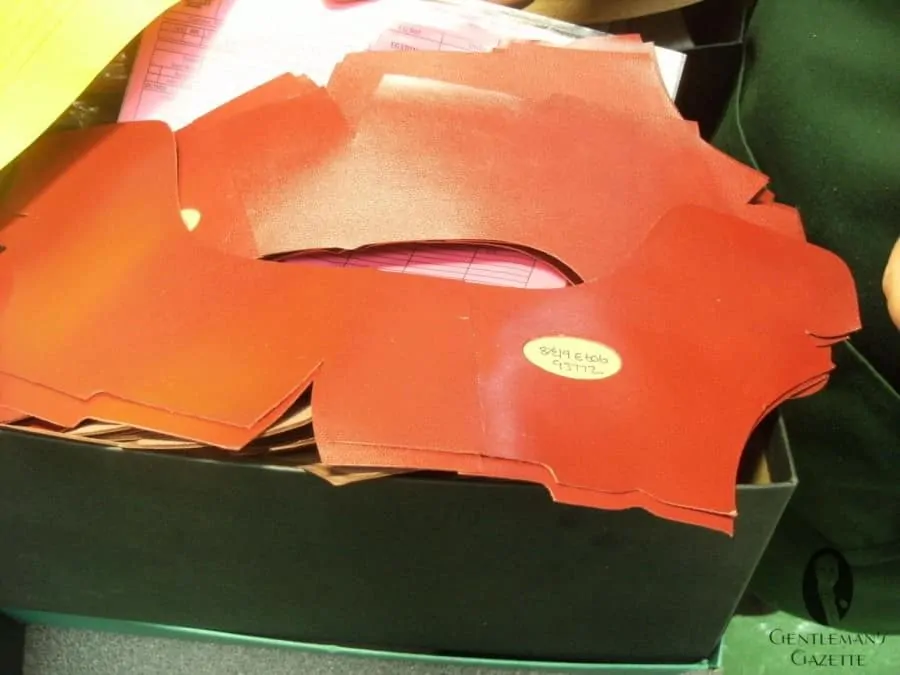
Most Goodyear-welted footwear has internal reinforcement of the toe box and heel, but Edward Green go one stage beyond this, reinforcing the sides of the shoe also, using carefully skived pieces of leather. This ensures that there will be a consistent degree of support for the foot from the whole shoe, incidentally prolonging the life of the shoe.
Next to the upper is the corresponding lining, in a quite sharp shade of red. I am shown the handwritten label inset into the lining – last number, size, followed by a unique shoe number. Each pair of Edward Green shoes has a unique number which can be traced back, should the shoe be returned for repairs.
Repairs
The longevity of their footwear is a matter of no little concern to some owners (no wonder, when one considers the cost of high-quality shoes). As testament to the reluctance of these owners to say goodbye to well-loved but elderly and well-worn shoes, a meticulously catalogued photographic archive records the condition of shoes that are returned to the factory for repairs. The repairs often go far beyond straightforward resoling and re-heeling, to include replacement of linings and, in cases where this cannot be avoided, of the inner sole also. In some cases shoes are returned that are twenty or even thirty years old; their patinaed uppers have attained conditions of great and distinguished character, and one can readily comprehend the reluctance of their owners to be parted from them. The photographs, and in some cases the actual preserved relics themselves, reveal the worn state of the inners – and in one case suggest that the owner had suffered a particularly nasty misunderstanding with a rotweiler, or perhaps a lawnmower, which had left part of his chukka boot very nastily mangled. (In this instance a highly elegant way had been found to repair the shoe with carefully matched calf-leather, yet retaining as much of the original as possible.) Here, Euan impresses upon me the importance of repairing shoes in good time; certainly before any of the cork infilling has been lost from the footbed.
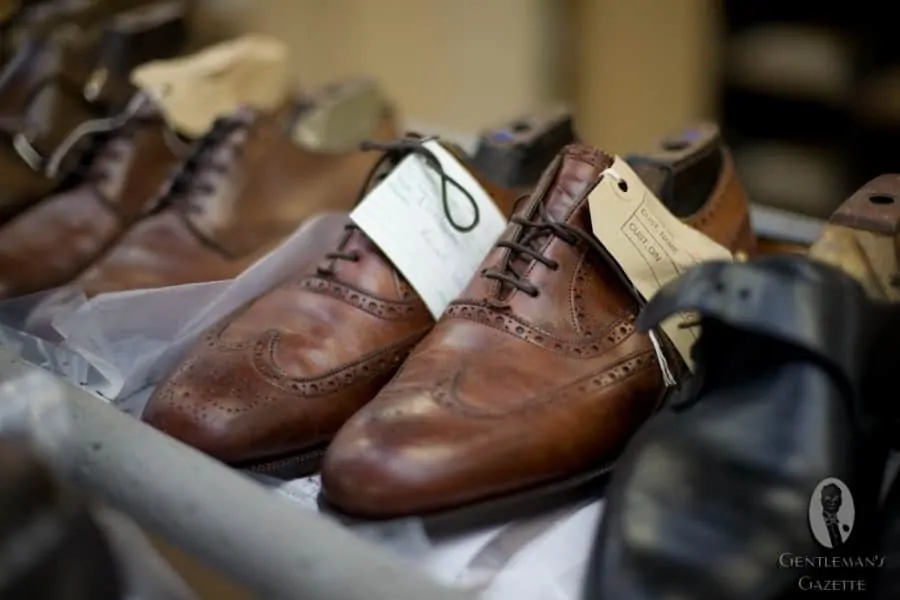
Down at the back of the closing room there is a discreetly enclosed area; the sanctum sanctorum, perhaps, of the whole factory, where reside two master craftsmen, jointly responsible for the hand-stitching of Norwegian uppers for which Edward Green have become well-known, although other companies offer this kind of hand stitching as well. This is carried out not with needles, but by a highly skilled process of delicate hand and eye coordination involving a pig’s bristle, onto which the waxed thread has been twisted. Using an awl, a small hole is opened in the adjoining edges of the leather being sewn, through which the bristle and attached thread are then passed. Great accuracy and consistency, besides steadiness of hand, are required for this, and I ask why a needle is not used; the answer, of course, is obvious – a needle would involve making a larger opening to pass through.
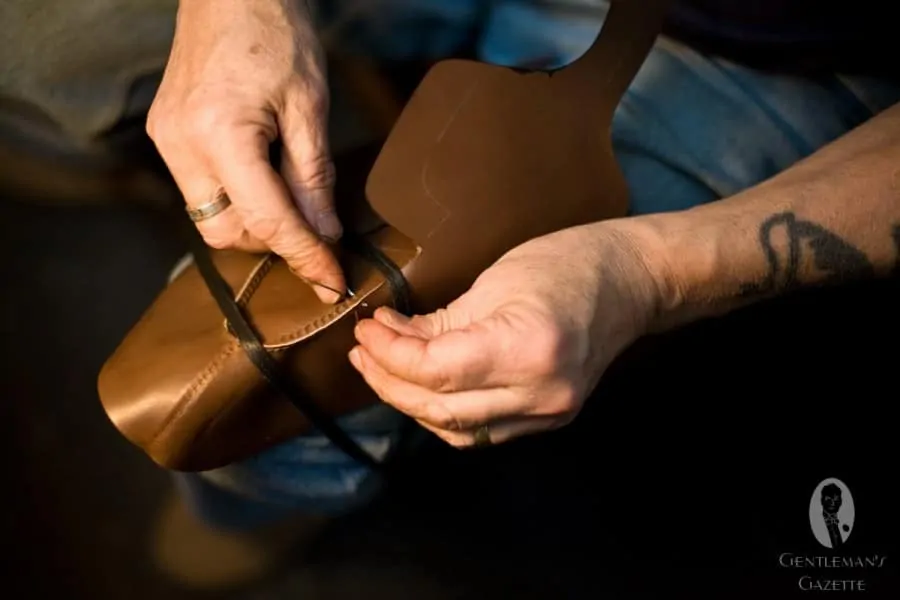
They are making uppers for Dovers, a model which features a handsewn apron and toe, and is very popular in Japan, where there is a great appreciation of this approach to shoemaking.
Lasting, welting and soling
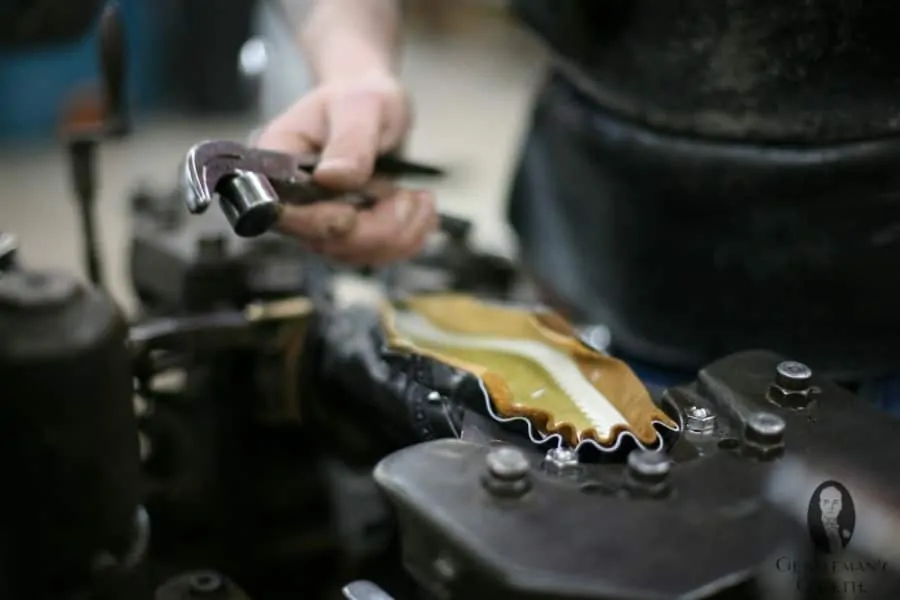
We move on to the lasting, welting and soling department, where again I find things are done somewhat differently. The lasting process, for instance, involves a team of three men and a type of machine that is unique to Edward Green – it is almost an antique, and takes a lot longer to draw the leather tight around the last, but it does so more thoroughly – in a way that ensures the upper will be drawn more tightly, and more smoothly, than is achieved by more modern machines operated by a single worker. The lasted uppers are then beaten by hand to achieve perfect smoothness and allowed to dry slowly, before they go on to be trimmed, welted, soled and heeled. The soling, as noted earlier, involves a channel which conceals the welt-stitch, a particular refinement that used to be seldom found in bench-made footwear, but is now available from almost all higher end goodyear-welted shoe manufacturers.
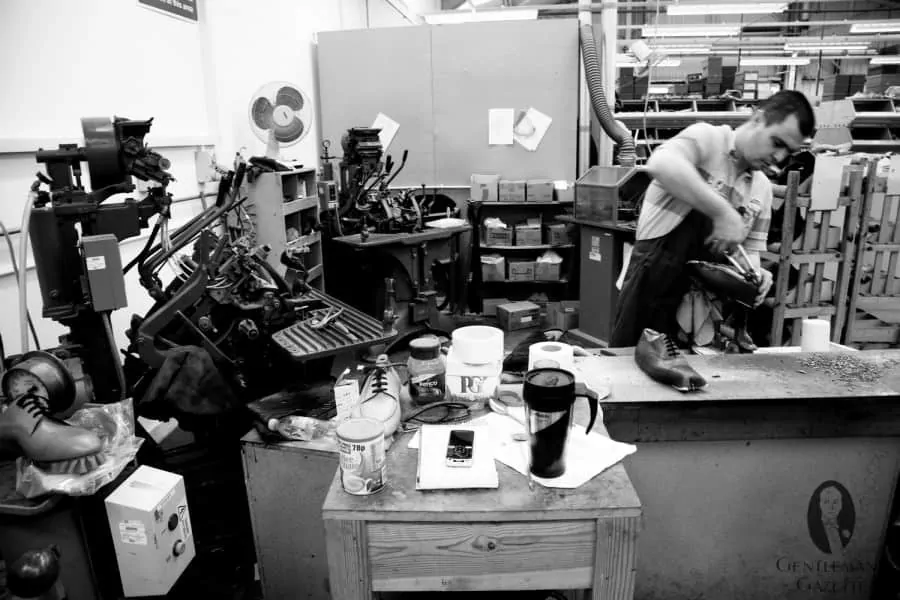
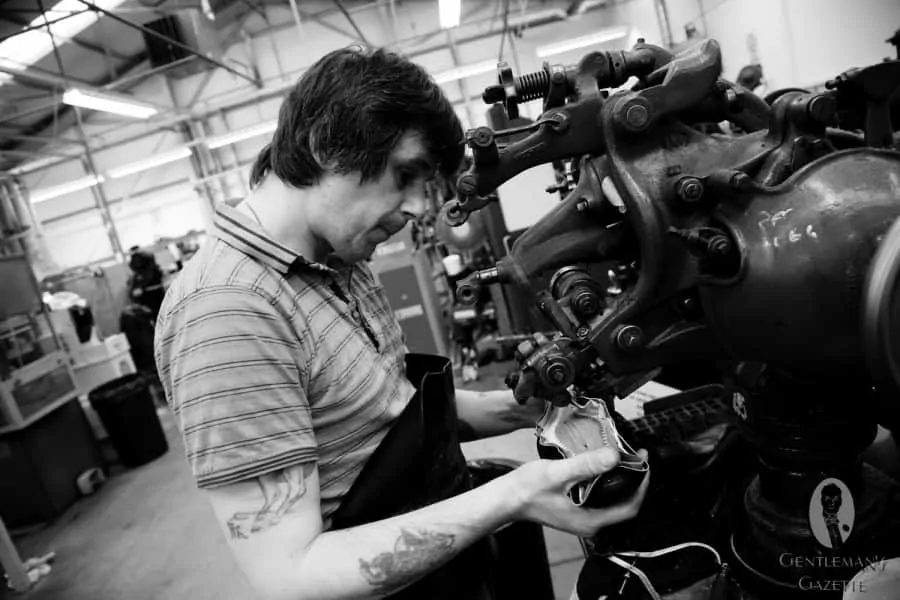
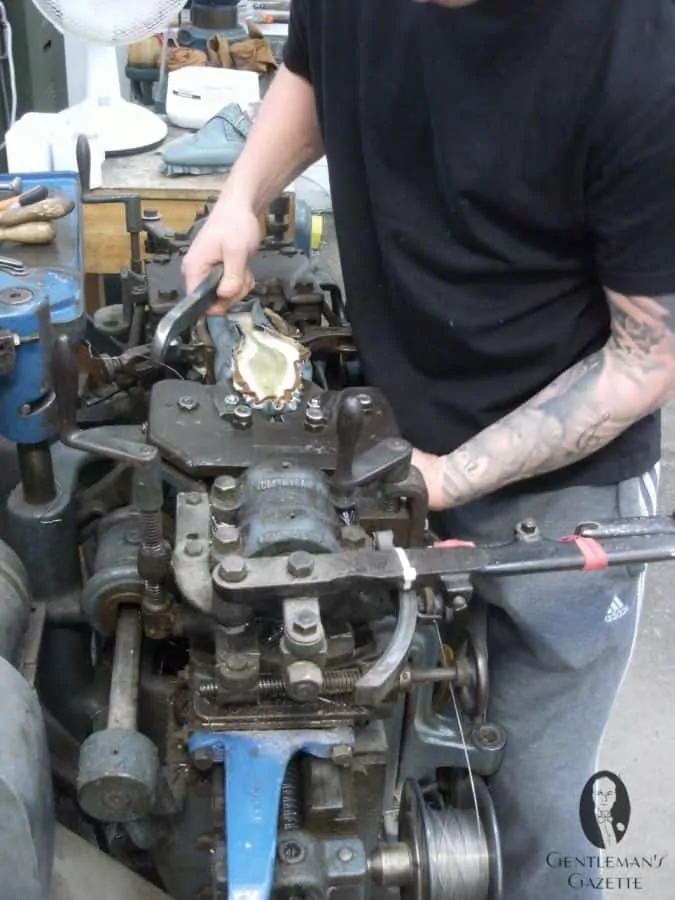
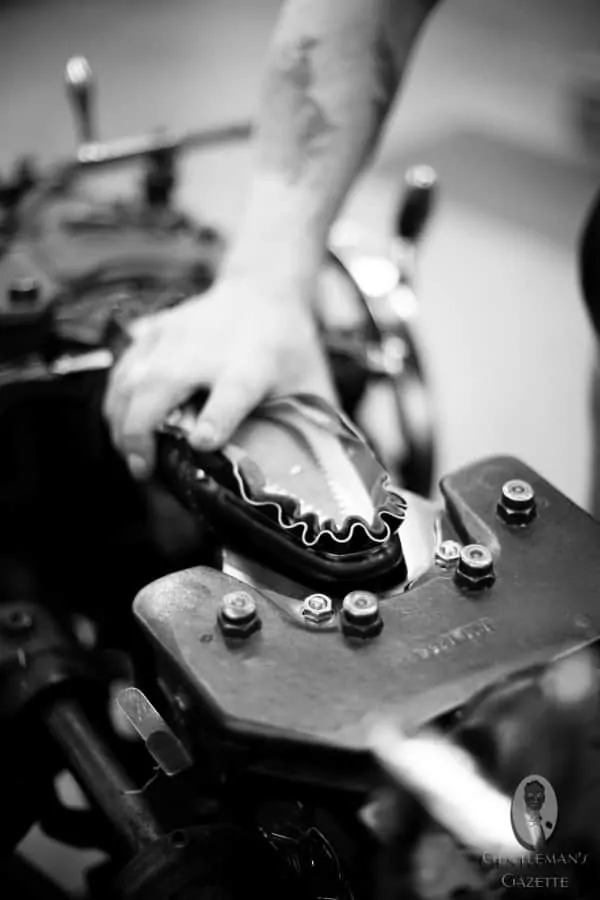
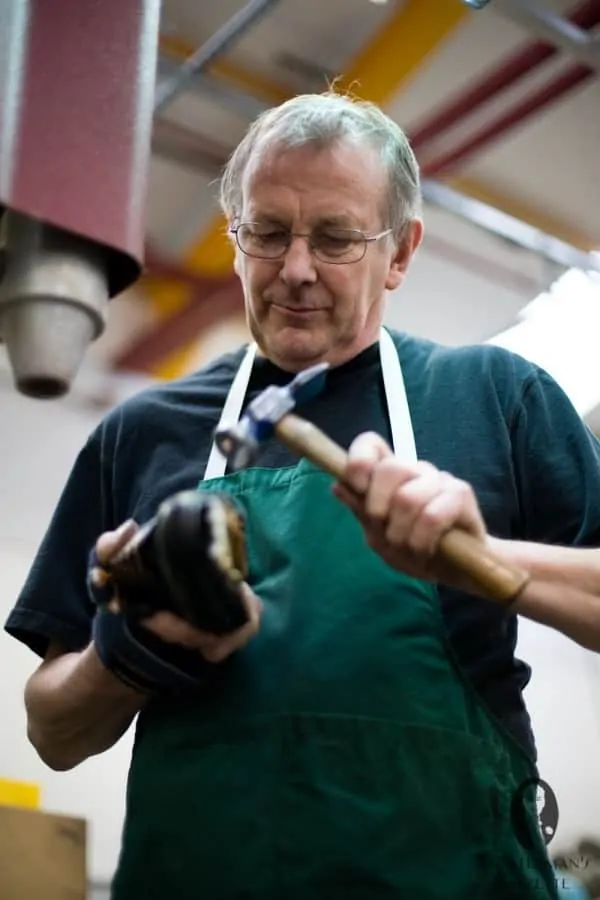
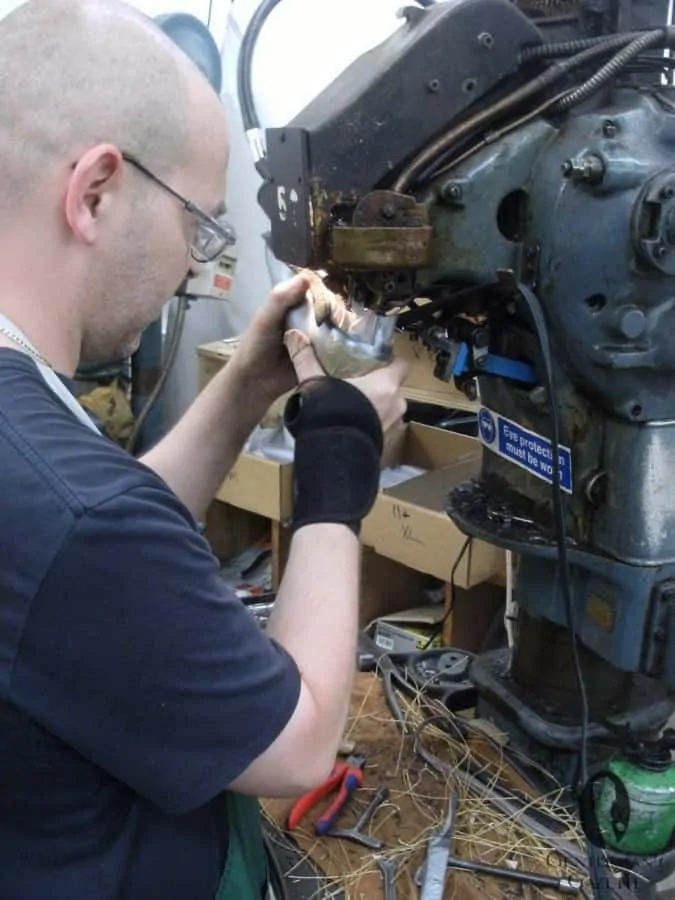
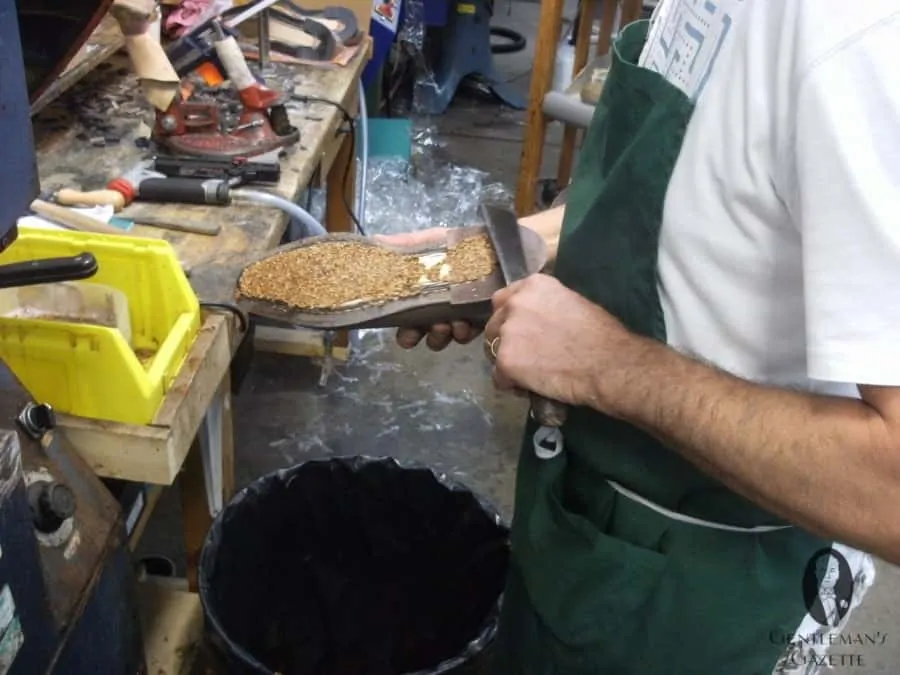
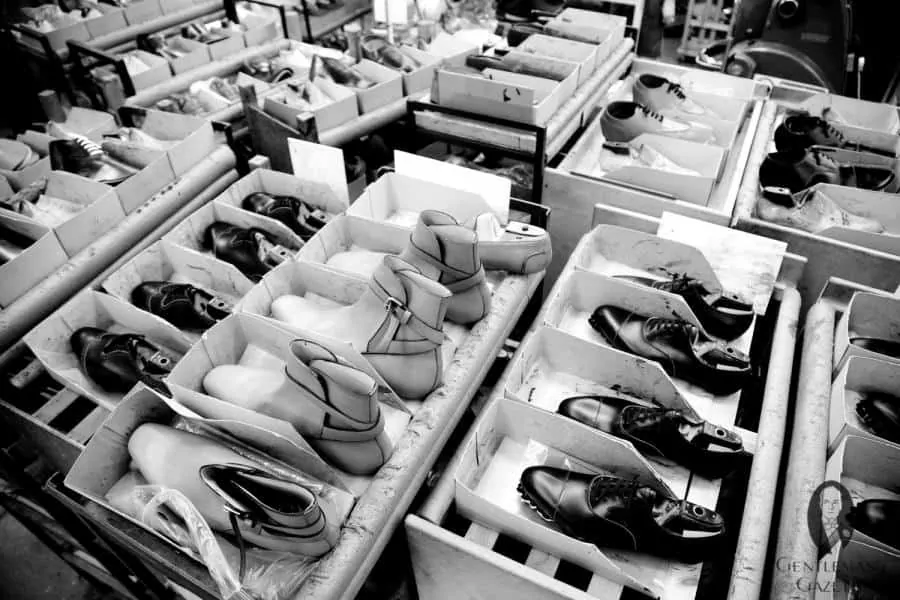
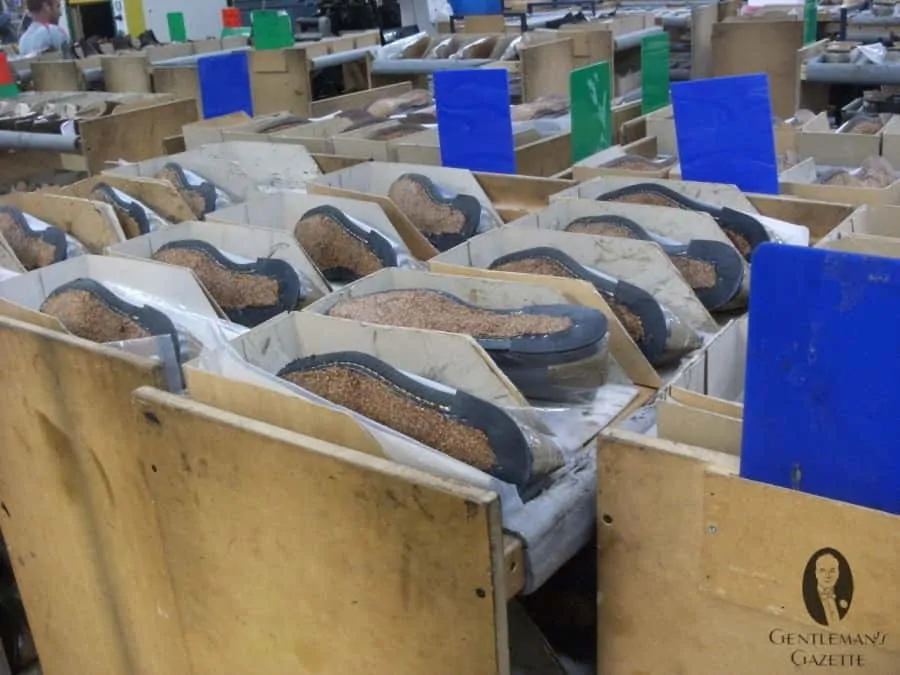
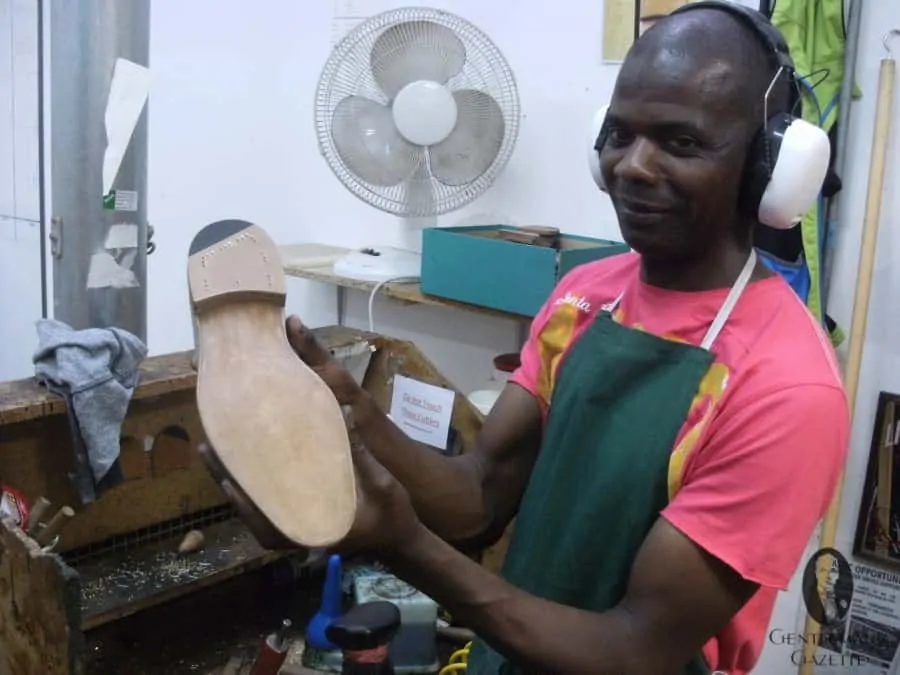
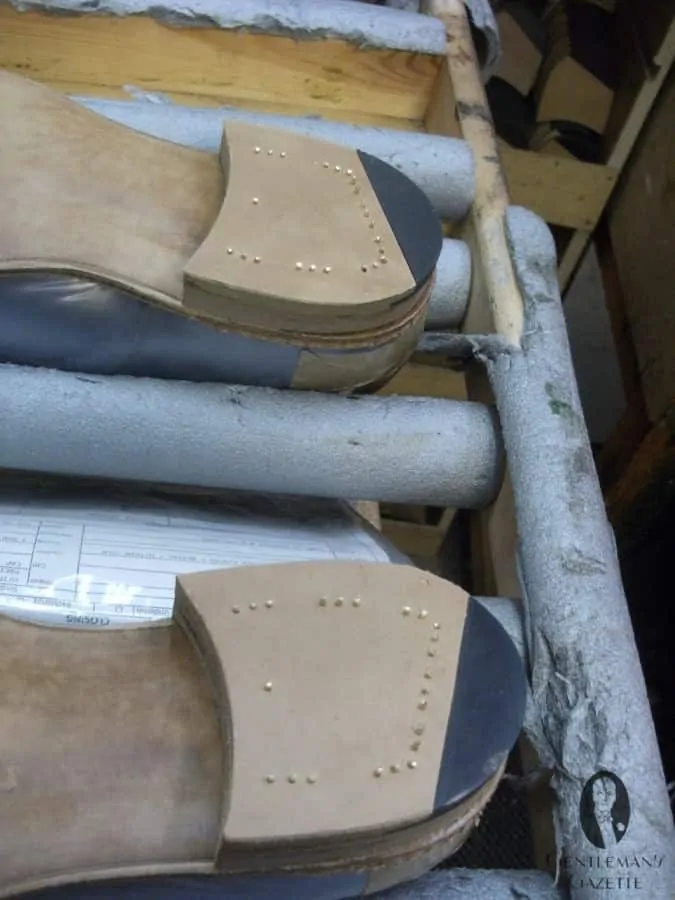
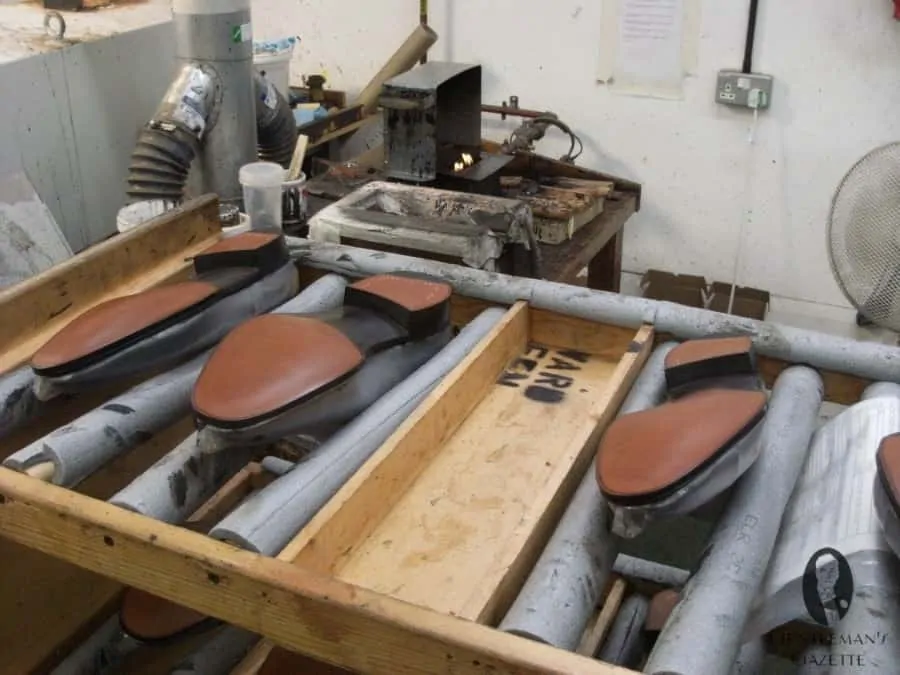
The finishing and burnishing department, of course, comes last, and involves techniques that I am asked not to photograph, but which, as one would imagine, involve a prodigious amount of polishing.
Edward Green’s key features
We return to the boardroom for a recap of Edward Green’s key features. Also, I am keen to learn about their MTO program. Euan sums up the former:
“Our key elements are real attention to detail in the craft: materials, components and processes. It’s all about having beautifully handcrafted products.
“In terms of the aesthetics, our shoe is very much an English shoe – it’s got a certain elegance to it [that word again], and you see that in the channel closing, the 12 stitches to the inch, and the last shape….
Our customers come to us because they love shoes above all else. There are different sorts of people who fall into that category. Thirty years ago there were many people who just had to wear classic good-quality menswear for work. Increasingly that isn’t the case. Our customers aren’t people who do things out of convention, but people who enjoy having a beautifully made shoe, whether it be classic or detailed in a more personalised way.”
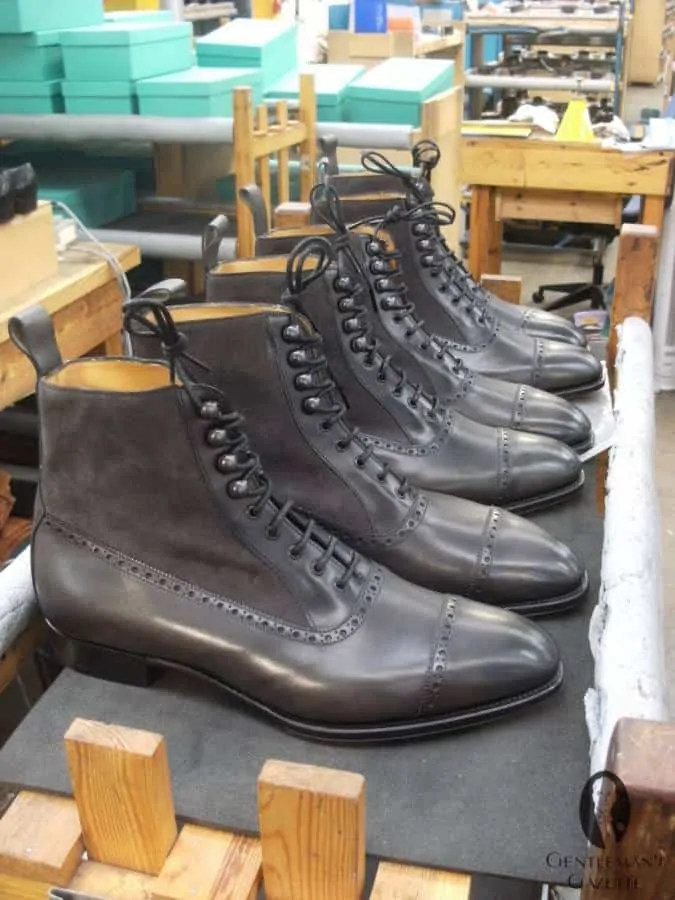
Edward Green’s made-to-order programme accounts for roughly 20 per cent of their sales. The customer chooses whichever EG last they prefer, in their size and width, in the design of their choice and choosing from a swatch of colours and calf types, while specifying whatever other details they require – a thicker sole, for instance. There is a three-month turnaround for this service, for which a premium of around £180 on top of the standard price is charged. So, for the customer for whom the stock Edward Green shoe is slightly mainstream, here is a way to make their shoes really special, truly unique to them. Or it may be just a question of fit – wanting a combination of width, last and design that is not normally available. It should be noted, however, that the standard designs can all be ordered in whatever size/width combination the customer requires, at the standard price.
Where to buy Edward Green
United Kingdom
75 Jermyn Street
London
SW1Y 6NP
Tel 020 7839 0202
email: [email protected]
Cliftonville Road
Northampton
NN1 5BU
Tel 01604 626880
www.edwardgreen.com
France
Edward Green Paris
199b Boulevard St. Germain
75007 Paris
France
Tel 00 33 153 634750
email: [email protected]
Japan
Edward Greenに関するお問い合わせ
リデア カンパニー リミテッド
〒107-0062 東京都港区北青山3-5-30 入来ビル 8F
Phone 03-3470-7384
Mail [email protected]
Netherlands
Shoes and Shirts
Havenstraat 23, 6211 GJ
Maastricht
Holland
Tel +31 (0) 433255518
Fax +31 (0) 433255536
Hermans Schoenen Since 1906 BV
Ouderkhof 22, 3512 GK
Utrecht
Netherlands
Tel +31 (0) 346252302
Fax +31 (0) 346252303
Russia
L’Ago d’Oro
Molochniy Per 4
119034
Moscow
Russia
Tel 0079857275255
email: [email protected]
United States
Saks Fifth Avenue
611 5th Avenue
New York, NY 10022
Tel 212-753-4000
Leather Soul Beverly Hills (LSBH)
Artist’s & Writer’s Building
479 Rodeo Drive #103
Beverly Hills, CA 90210
Tel 1.310.248.2399
Fax 1.310.248.2389
Leather Soul Hawaii
The Royal Hawaiian Center
2233 Kalakaua Avenue # 301
Honolulu, HI 96815
Tel 1.808.922.0777
Fax 1.808.922.0779
Shop
Leffot
10 Christopher Street (corner of Gay Street)
New York, NY 10014
(212) 989-4577
[email protected]
Shop
Sky Valet
1800 Wisconsin Ave NW
Washington, DC 20007
(202) 337-4333
Shop
EG: I had a dreadful experience with trying to do a special order thru their Washington, DC retailer: Sky Valet. I was measured by
an Edward Green experienced rep, and given a surcharge: the shoe was unwearable.! A size too large and the wrong width.
I wear in Edward Green a 5 E!
They took the special order back, and made another, but thought I wanted both pairs! They finally sent Sky Valet the new pair,
which OK, but still not great. They also sent another pair of shoe trees, and Sky Valet begged me to keep them since they, Sky Valet would get charged for them anyway. Sky Valet is clearly intimidated by EG, and I think they would have done a better job to
measure to begin with.
I went to another trunk shoe at Sky Valet and theEG reps were completely unresponsive to my unhappiness about being charged
for special order by their worker, and it didn’t fit. I found the EG US rep loathesome.
I actually had Gaziano “stretch” them on G&G’s 5E last and they know fit very nicely. Since them I’ve been a G&G customer.
I think their pricing is out of line, and they are famous for lousy customer service on
repairs or returns. (see the other fora). The London EG shop also is staffed by indifferent sales people.
I am afraid to order more from them, although I like their designs. I have no confidence that another EG 5E on their 202 last would fit, and I resent the surcharge for “special order.” There was nothing special order about my EG shoes, but they deemed them
special order because they don’t routinely make 5E, although it’s considered a stock size
Dear Terry,
Can you please tell us more about your experiences with Edward Green? Thank you
That doesn’t sound great indeed and I can understand why you would choose someone else after this experience. I guess some people get along and others don’t. In any case, I think your comment is valuable for other readers who may want to order a MTO shoe.
Ideally, one should try on a well fitting last so there are no surprises upon delivery.
On the other hand, it is important to know what you agreed on before you bought the shoes. If you agreed on a great fit and the second one still does not fit, I’d return them again and ask for my money back.
We all make mistakes and that’s ok, but it’s the way we handle them that reveals our character.
I’m slightly surprised by your comments on EG’s repair service. As I tried to convey in my article, they go to considerable trouble to document repairs – although how long this has been their policy I am unable to say – and feel they would be unlikely to go to these lengths if the repairs were going to be substandard in any way.
I have learned elsewhere that EG no longer sell through Sky Valet.
I just did a thorough search of the Saks Fifth Avenue site for New York City and there was nothing by Edward Green. I did some more searching online, and it looks like they used to carry them, but not anymore. I searched Barneys also.
They are on the website for Leffot on Christopher street though.
Terry – could you illustrate your comment with a for instance or two?
JC – I had it from Mr Denholm that Saks carry their shoes. Perhaps they just aren’t on Saks’s website?
I updated his comment with the information he provided.
I enjoy buying shoes, the best quality I can afford. As they last for years, I see little reason to prevent myself paying several times what others are willing to pay.
First impressions count, one of the reasons why the shoes you wear tell others the kind of person you are.
Perhaps we could hear from one or two readers whose experience of EG’s customer service has been somewhat better than that described by Terry Teplitz? Anyone?
They deem them “special order” so that you can’t return them! That is a problem in that they never
have a shoe in my size to try on. So you have to “trust them” (with your non refundable money).
Similarly, Leffot makes it clear no returns on “special order” whether it’s EG or Alden, or anything.
That makes it impossible for someone like me to order with confidence. I should point out that
I don’t as a rule return things. I found the EG sales model unacceptable. They don’t really want
my business.
Customers should always investigate MTO terms and conditions carefully before entering into such arrangements – the possibility of the order proving unsatisfactory, and what happens then, should be considered.
As Leffot impose the same conditions on orders for Alden (and other makers?) as on those for EG, is this complaint specific to EG, or to MTO arrangements more generally? I understand the disappointment that can ensue when special orders fail to fulfil one’s expectations, having experienced this a few times myself, but quite often these problems can be resolved satisfactorily.
Discussing the possibilities of shoes that do not fit is definitely in order but if the sales person says it will, then I don’t think they should point to their terms. If you talk to a company rep and he ensures you it will fit, then you can ask for a shoe that fits. Considering that it is a MTO program I doubt, any serious salesperson will do that, however we can all make our own promises.
On another note, how much does the EG repair service cost?
I believe each repair is costed separately – there were some quite unusual repairs going through when I visited. When I suggested, in view of the very extensive nature of the repairs, that the customers might save themselves some money by simply buying new, I was not contradicted! For a straightforward resoling and reheeling, other firms seem to charge between one-third and half of the cost of a new pair, which I would imagine might follow for EG but I cannot confirm this.
Thank’s for a thorough and indepth article. I just ordered my first pair of EGs, MTO Gallways, however contrary to what EG seems to have indicated the MTO programme does not allow the client to choose the last but they impose the last they believe will look best
When I was first interested in buying a pair of EG shoes, their service was nothing but stellar. Upon request I was given, I think it was by Hilary Freeman herself, the addresses of their partners in Germany and Switzerland, they sent a catalogue and answered two or three questions about their MTO-program. I subsequently ordered some shoes. The service from the shop was fine, the fit was alright, but I feel another last would have been more suitabe for my feet, but no blame for EG. The same things can be said for their store in London, friendly and knowledgable staff, who were very patient although I decided againt buying a pair, as their stock didn’t appeal to me.
A couple of years on (about 5 or 6, though I would have to lie) things have become worse. No reply to any of my e-mails and their staff in London seems to have been replaced by salesmen who seem to care about numbers sold instead of fit. Though to be fair, the same can be said for some of Crockett and Jones’ staff in London. I think they’ve become too big for their own good. Quite a few of the problems occured when the bigger online forums turned on them, around the time of Gaziano and Girling popped onto the scene. They’ve also expanded the number of their partners and instead of working together with smaller stores, their shoes are now available at Görtz, a German highstreet brand who stocks most of the higher-end brands from Northampton.
To follow up, I wear a 5E in EG with the 202 last. Because my feet are small and narrow, no
maker ever has a shoe for me to try on for size. I found it interesting that the EG 5E on the 202
last, wasn’t great but it was wearable. It became superb after Tony Gaziano kindly had it “stretched”
to conform to his 5E last, on his particular GG last. The point is, I am forced into a special order
with an new maker, and that leads to trouble.
In Budapest, Eva Vass, couldn’t fit me either, so I ended up with her so called “bespoke” which fit quite well given there was no try on. I did have several pair of Vass made by mail after that. I really only liked their Norweiger in terms of style.
I go to Stockholm in November, and am mulling over the options there. No more EG experiments for me, thank you.
I have been in contact with EG about this, Terry. I should point out that any customer visiting EG in London can try on a 5E in several lasts. EG also assure me that “Our shop will always bend over backwards to ensure that the fit is as it should be, including returning it to the factory for extra work if they feel it’s not as it should be.” Whether this is any help to customers in the States I cannot say, but feel I should convey this response to some of your comments.
Thanks for adding this information Christopher. What people say and what they do, are different but it’s good to know they offer the 5E size and are committed to provide well fitting shoes.
That is all well and good, but their factory rep measured me, and with about $200
surcharge fit me in a different size and width! I live in Washington, and although frequently
in London, one would think the factory rep going thru the pseudo ritual of pencil tracing
would have a good chance for a factory fit.
What they don’t tell you is that EG forced the retailer to absorb the loss on the first, incorrectly
sized MTO. Not very sporting.
Finally, why is 5E a special order upcharge to begin with?
From what I was told, 5E would seem to be a standard size – but I don’t know whether that is throughout their range, or certain models only. Your account is rather troubling to me. I presume you have already related the problem to Edward Green in Northampton?
This was some years ago: the experience was sufficiently off putting that I’ve been a G&G
customer since. 1) The issues are: surcharge for shoes that were the wrong size 2) song and
dance about redoing it in the correct size 3) having to buy another set of shoe trees 4) the hapless
retailer subsidizing their errors…
The other striking recollection was the absolute terror the retailer demonstrated in trying to
deal with the transaction and their recourse with EG. I’ve never seen anything like it. The U.S.
rep. literally walked away when I commented on why I was there (again): to return the first pair
and try to get another pair in the correct size made.
Axel’s has a unique collection of Edward Green shoes. Pretty different selection than most men’s stores.
http://axelsltd.com/mens/shoes